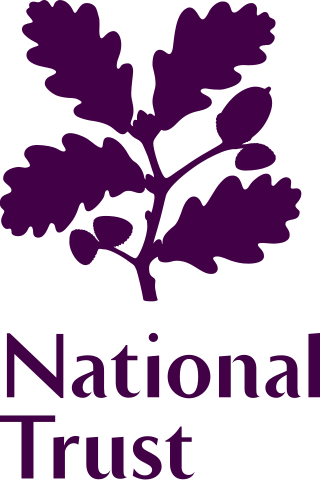Related Research Articles

Owls are birds from the order Strigiformes, which includes over 200 species of mostly solitary and nocturnal birds of prey typified by an upright stance, a large, broad head, binocular vision, binaural hearing, sharp talons, and feathers adapted for silent flight. Exceptions include the diurnal northern hawk-owl and the gregarious burrowing owl.

Barn-owls are one of the two families of owls, the other being the true owls or typical owls, Strigidae. They are medium to large owls with large heads and characteristic heart-shaped faces. They have long, strong legs with powerful talons. They also differ from the Strigidae in structural details relating in particular to the sternum and feet.

The National Trust is a heritage and nature conservation charity and membership organisation in England, Wales and Northern Ireland.
Bot or BOT may refer to:

Dartington Hall in Dartington, near Totnes, Devon, England, is an historic house and country estate of 1,200 acres (4.9 km2) dating from medieval times. The group of late 14th century buildings are Grade I listed; described in Pevsner's Buildings of England as "one of the most spectacular surviving domestic buildings of late Medieval England", along with Haddon Hall and Wingfield Manor. The medieval buildings are grouped around a huge courtyard; the largest built for a private residence before the 16th Century, and the Great Hall itself is the finest of its date in England. The west range of the courtyard is regarded nationally as one of the most notable examples of a range of medieval lodgings. The medieval buildings were restored from 1926 to 1938.

The River Aln runs through the county of Northumberland in England. It rises in Alnham in the Cheviot Hills and discharges into the North Sea at Alnmouth on the east coast of England.
Dorset Wildlife Trust (DWT) is a wildlife trust covering the county of Dorset, United Kingdom. The trust was founded in 1961 as Dorset Naturalists' Trust, to protect and conserve the wildlife and natural habitats of the county.

Durham Wildlife Trust is a registered charity that was established in 1971, originally as the Durham County Conservation Trust, becoming Durham Wildlife Trust in 1988. The Trust operates across the area of the old County Durham, which includes Darlington, Gateshead, South Tyneside and Sunderland.

The South Devon Railway (SDR) is a 6.64-mile (10.69 km) heritage railway from Totnes to Buckfastleigh in Devon. Mostly running alongside the River Dart, it was initially known as the Dart Valley Railway. The railway is now operated by the South Devon Railway Trust, a registered charity.

Cookbury is a village and civil parish in the local government district of Torridge, Devon, England. The parish, which lies about five miles east of the town of Holsworthy, is surrounded clockwise from the north by the parishes of Thornbury, Bradford, Ashwater, Hollacombe, and Holsworthy Hamlets. In 2001 its population was 158, little changed from the 146 residents it had in 1901.

Hestercombe House is a historic country house in the parish of West Monkton in the Quantock Hills, near Taunton in Somerset, England. The house is a Grade II* listed building and the estate is Grade I listed on the English Heritage Register of Parks and Gardens of Special Historic Interest in England.

The South Western Ambulance Service NHS Foundation Trust (SWASFT) is the organisation responsible for providing ambulance services for the National Health Service (NHS) across South West England. It serves the council areas of Bath and North East Somerset, Bournemouth, Christchurch and Poole Council, Bristol, Cornwall, Devon, Dorset, Gloucestershire, North Somerset, Plymouth, Isles of Scilly, Somerset, South Gloucestershire, Swindon, Torbay and Wiltshire.

The Devon Air Ambulance Trust (DAAT) is a charity providing emergency medical services through the provision of two helicopter-based air ambulances and two critical care cars, which cover the county of Devon in South West England. The helicopters and cars are owned and operated by the charity, which raises money from public donations and its charity shops.

The Donkey Sanctuary is a British charitable organisation devoted to the welfare of donkeys. The charity, which is based near Sidmouth in Devon, England, was founded in 1969. It is one of the largest equine charities in the world with an annual income and expenditure of £37 million.

The A382 is a road in South West England, connecting Newton Abbot to the A38, then to Bovey Tracey and on through Moretonhampstead to the A30.

Devon Birds, known as the Devon Bird Watching & Preservation Society from its founding in 1928 until it was renamed in 2005, is one of the UK's regional ornithological societies.
Powdered corn cob (PCC) is a rodenticide, marketed as a natural and environmentally-friendly alternative to anticoagulant types. The preparation was approved in July 2013 under the European Biocide Directive Program. It works by causing acute and ultimately lethal dehydration.

The western barn owl is usually considered a subspecies group and together with the American barn owl group, the eastern barn owl group, and sometimes the Andaman masked owl make up the barn owl. The cosmopolitan barn owl is recognized by most taxonomic authorities. A few separate them into distinct species, as is done here. The western barn owl is native to Eurasia and Africa.

Ideford is a village in the Teignbridge district of Devon, England. It is 5 miles (8 km) north of Newton Abbot. To the west is the A380 dual carriageway and to the east are Luton and Teignmouth Golf Club. The former single carriageway A380 used to pass over a lane on the "Ideford Arch" but the route is now overgrown.

Jane Parminter (1750–1811) and Mary Parminter (1767–1849) were cousins and British travellers and designers from Devon who commissioned and were involved in designing the sixteen-sided house named A la Ronde. They also built a chapel, called Point in View, a schoolhouse for local girls and almshouses for local spinster women on the site, and set up wills that passed the properties from women to women.
References
- ↑ The Barn Owl Trust
- ↑ Charity Commission
- ↑ Devon Great Outdoors death toll
- ↑ "Survey Techniques - The Barn Owl Trust" (PDF). Archived from the original (PDF) on 1 February 2013. Retrieved 18 March 2013.